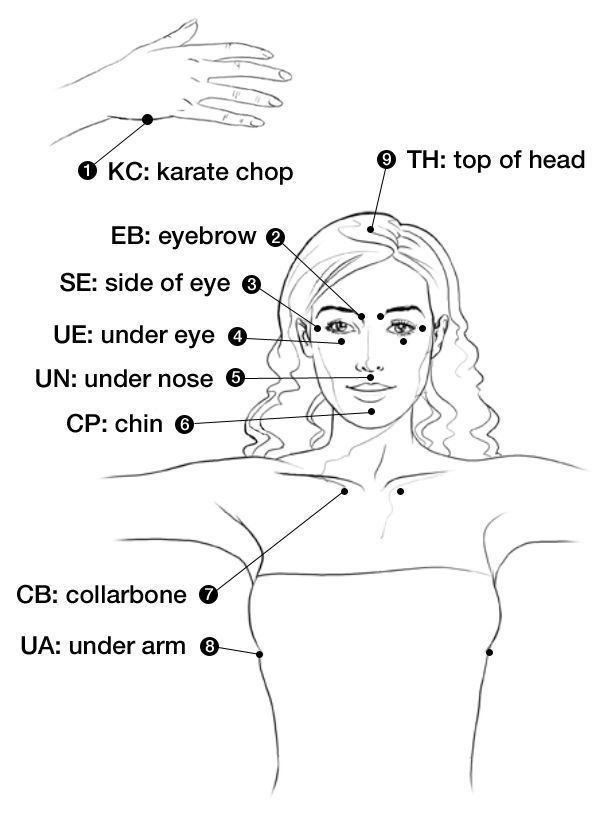ALL POSTS
20/09/2024
EFT tapping. Emotional freedom technique
What is EFT Tapping? The Emotional Freedom Technique (EFT) is a therapeutic approach used to address both physical pain and emotional challenges. Known commonly as "tapping" or psychological acupressure, this technique involves tapping on specific points of the body to promote healing and emotional release.
Supporters of EFT believe that this method helps re-establish balance within the body’s energy system, which can alleviate pain or distress. The method’s originator, Gary Craig, proposes that disruptions in energy flow are the underlying cause of many negative emotions and physical discomforts.
While scientific research is still exploring EFT’s full effectiveness, it has already been used as a tool to assist individuals dealing with anxiety, stress, and post-traumatic stress disorder (PTSD).
How Does EFT Tapping Work? Much like acupuncture, EFT focuses on energy points or "meridian points" to help restore balance to the body’s energy field. This balance is thought to play a role in relieving negative symptoms caused by emotional or physical stress.
Meridian points, according to traditional Chinese medicine, are energy channels that run through the body. They serve as pathways that help maintain proper energy flow, which is essential for overall health. When these energy pathways are blocked or imbalanced, illness or emotional disturbances can arise.
In contrast to acupuncture, which uses needles, EFT relies on tapping with fingertips on these meridian points. This is believed to help access the body's energy system and signal to the brain to reduce stress. Tapping on these points, combined with mentally focusing on a problem, is thought to assist in balancing energy and alleviating negative feelings.
The Five-Step Process of EFT Tapping EFT tapping can be broken down into five main steps, and this process can be repeated for different issues or emotions that need to be addressed.
Identify the Issue The first step is to pinpoint the specific issue or fear you want to address. This becomes your focus during the tapping process. It is believed that concentrating on one problem at a time can improve the effectiveness of the technique.
Measure Initial Intensity Once the issue is identified, you then assess the severity of the emotional or physical discomfort it causes. You assign a number to this intensity on a scale from 0 to 10, with 10 being the highest level of discomfort. This measurement helps track progress as you move through the tapping sequence. If, for example, you start with an intensity level of 8, and it drops to 4, you have achieved a 50% reduction in intensity.
The Setup Phrase Before beginning the tapping process, you develop a "setup phrase" to frame your focus. This phrase should accomplish two things: acknowledge the issue and express self-acceptance despite the problem. The most common setup phrase used is: "Even though I have this [problem], I deeply and completely accept myself."
This phrase can be adapted to fit your specific issue, but it must be focused on your own feelings rather than someone else's. For example, instead of saying, "Even though my mother is sick," you would rephrase it to, "Even though I feel sad about my mother being sick, I deeply and completely accept myself." This way, the focus remains on your personal emotional response to the situation.
- EFT Tapping Sequence The main part of EFT involves tapping on nine meridian points while repeating a reminder phrase that keeps you focused on the issue.
The key tapping points correspond to different meridian lines in the body. They include:
- Side of the hand (sometimes called the "karate chop" point) — small intestine meridian
- Eyebrow — bladder meridian
- Side of the eye — gallbladder meridian
- Under the eye — stomach meridian
- Under the nose — governing vessel
- Chin — central vessel
- Beginning of the collarbone — kidney meridian
- Under the arm — spleen meridian
- Top of the head — governing vessel
To start, tap the side of the hand while repeating your setup phrase three times. Then, tap each of the nine points in the following order, tapping seven times on each: Eyebrow, side of the eye, under the eye, under the nose, chin, beginning of the collarbone, under the arm, top of the head.

While tapping, you can repeat a reminder phrase that keeps you focused on the emotion or issue you're working on. For example, if your setup phrase was, "Even though I feel sad about my mother being sick," your reminder phrase could be, "The sadness I feel about my mother's illness."
This sequence is typically repeated two or three times, and each tapping point is revisited to ensure that the energy flow is addressed.
- Test Final Intensity Once the tapping sequence is completed, reassess the intensity of the problem on the 0-10 scale. Compare this new intensity with your initial assessment. If the issue still feels unresolved or hasn't reached a zero intensity level, repeat the process until it does.
Effectiveness of EFT Tapping EFT has gained attention for its effectiveness, particularly in addressing PTSD in war veterans. In a study conducted in 2013, researchers found that veterans who received EFT tapping therapy significantly reduced their psychological stress levels compared to those who received standard care. Over half of those who participated in the EFT sessions no longer met the criteria for PTSD after treatment.
In addition to PTSD, EFT has shown promise for managing anxiety. A 2016 review compared EFT tapping to conventional anxiety treatments and found that EFT produced better outcomes for managing anxiety symptoms.
Further research has highlighted EFT’s potential in other fields. For instance, a 2022 study revealed that EFT tapping significantly improved self-esteem in nurses. Similarly, a 2023 study showed that EFT helped reduce stress and anxiety in healthcare workers during the COVID-19 pandemic.
While more research is needed to compare EFT with other therapeutic methods like cognitive-behavioral therapy (CBT), EFT remains a recognized technique for helping people manage anxiety, depression, physical pain, and emotional disturbances.
SIMILAR POSTS
01/10/2022
Love and relationships & with self and others
To not get lost in humanness but to be aware of being human.




